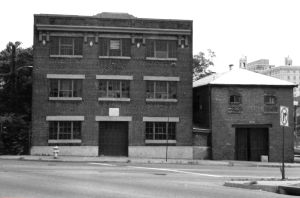From Josephine Ensign’s blog, “Medical Margins”:
The Street Center was thick-walled and cavernous. It was located in the armpit of town, on the border between Monroe Ward, Gamble’s Hill, and Oregon Hill near the James River. Built on land that had been the old city dump, the building had been a gas meter repair shop for the city as well as a storage unit for abandoned bicycles. The city donated the building as a way to appease the downtown merchants who wanted to get the street people—the visible homeless—away from their struggling businesses. Kudzu vines draped over trees and telephone polls; they formed a convenient curtain to block the public’s view of the ugly, forbidding looking building.
The Street Center was located at the corner of Belvidere and Canal Streets, with the main entrance on Canal. The building was flush with the narrow sidewalk. Belvidere Street, a busy four lane divided highway that ran north to south, was part of US Route 301 extending down to Sarasota, Florida, and up to Delaware. Across Belvidere from the Street Center was a 7-11 that sold cigarettes, cheap beer and flavored wine like Boone’s Farm and Thunderbird, all popular with the Street Center clientele. South of the Street Center were the hulking brick buildings of the Virginia Penitentiary, and just to the west was Hollywood Cemetery where a relative of mine—Jefferson Davis—and 20,000 confederate soldiers lay buried. In the block north of our building was a Hostess Twinkie factory. The sweet buttery smell of the factory mingled with the acrid smells of the Street Center: damp oil-stained concrete, souring unwashed bodies, old urine, and cigarette smoke.
When the Street Center opened in April 1986, homelessness was getting extensive national and local attention, with almost daily newspaper and TV news coverage. In May of that year, USA for Africa teamed up with Coca-Cola to sponsor Hands Across America to raise money for “fighting hunger and homelessness.” They had thousands of people hold hands for 15 minutes in cities across the nation. President Reagan joined in the hand holding from the White House, reportedly shamed into doing it by his daughter. There was a sense that homelessness—at least this new version of homelessness—could be cured.

